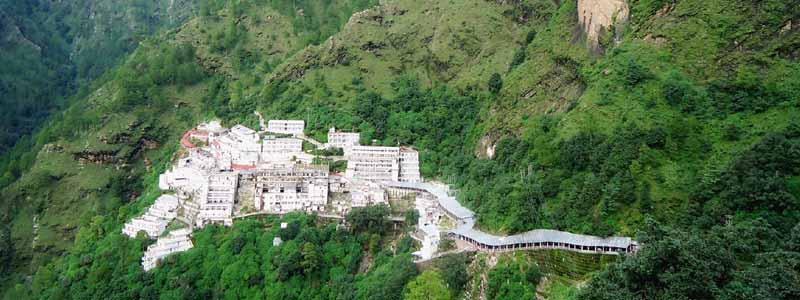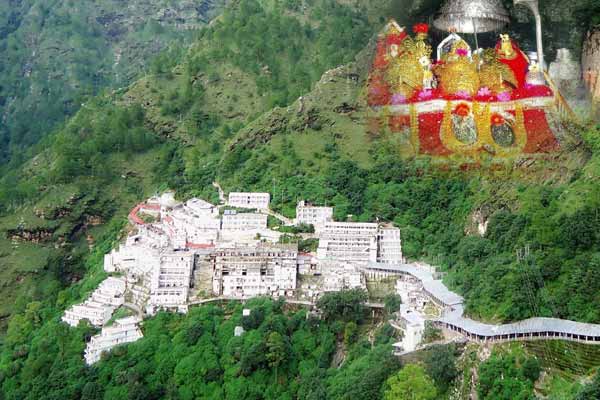Vaishno Devi Yatra Travel Guide, also known as Mata Rani, Trikuta and Vaishnavi, is a manifestation of the Mata Adi Shakti Hindu Goddess, also known as the Goddess of Mahalakshmi / Matrika. In India, the words “maa” and “mata” are frequently used for “mother” and are thus also used in connexion with Vaishno Devi.
In Kud, a wide range of trekking options are available. In the adjoining areas in the wilderness, there are excellent camping sites. There is a trekking equipment hire shop in the Tourism Department. Local and imported trekking gear is stocked in these stores. Equipment for a security deposit is available. Your passport would be held as a deposit if you are a foreign national. Many travel agencies also organise hikes around this area.
One of the holiest pilgrimages of our time is considered a pilgrimage to the Holy Shrine of Shri Mata Vaishno Devi Ji. Shri Mata Vaishno Devi Ji is popular around the world as Moonh Maangi Muradein Poori Karne Wali Mata, which means, the Mother who fulfils whatever Her children want, resides in a Holy Cave located in the folds of the Trikuta (pronounced as Trikoot) three peaked mountain. The Holy Cave annually draws millions of devotees. Currently , the number of Yatris annually visiting the Holy Shrine now exceeds one crore. This is due to the unflinching confidence of the devotees from all parts of India and abroad who throng the Shrine.
The Mother’s Holy Cave is located at an altitude of 5200 ft. The Yatris must make a trek of almost 12 km from the base camp at Katra. At the end of their pilgrimage, the yatries, inside the Sanctum Sanctorum-the Sacred Cave, are blessed with the Darshans of the Mother Goddess. Three natural rock formations called the Pindies are in the shape of these Darshans. Within the cave, there are no statues or idols.
The management of the Shrine and the regulation of the Yatra have been entrusted to the Board since the year 1986, when the Shri Mata Vaishno Devi Shrine Board (commonly called the Shrine Board) was created. A variety of developmental initiatives aimed at making the Yatra a relaxed and rewarding experience for the Yatris have been carried out by the Board. The Board continues to reinvest the offers and contributions received in the implementation of changes to different types of Yatri facilities.

History of Vaishno Devi
The Mata Vaishno Devi Shrine Board was founded in 1986 and many Hindu pilgrims have been drawn to this most famous religious site in Jammu ever since.
Mata Vaishno Devi ‘s holy cave is said to have been found by a Hindu priest, Pandit Sridhar. In the priest’s dream, Goddess Vaishnavi appeared and instructed him how to find a home on the Trikuta Hills here. Following her orders, the priest sets out for the journey after the dream and finds the cave as previously instructed. Mata Vaishno Devi appeared to him and, having four sons, blessed him. She gave him the advantage of being the custodian of the cave, too. Also today, the offspring of Pandit Shridhar stick to the vow.
Important places en route to Maa Vaishno Devi Holy Bhawan
Adhkuwari-Adkuwari is situated 6 km from Katra, which is a holy cave that sits at an altitude of 4,800 ft. Pure passing through the cave is believed to wash away the past sins of one’s life. Only one person at a time can travel through the cave when the cave is very narrow.
Himkoti- Himkoti is a picturesque place lying on a new road. It is located in Adhukwari, 2.5 km away. Yatris enjoy this place’s gripping beauty. From where yatris get to taste the picturesque with the whole valley, a viewpoint by Vaishno Devi Shrine Board was built here.
Sanjhichatt-Sanjhi Chatt is the highest point of the trek, set at a splendid height of 6,200 ft. Holy Bhawan is situated 2 km from here. A helipad that runs helicopter services between Katra and Sanjhi Chatt is present here. Yatris travelling by helicopter to Vaishno Devi have to deboard the helipad here and then continue the journey ahead.
Bhairon Ghati-The temple of Bhairon is located on the old track path. Devotees pay homage at Bhairon temple after the darshan at the Holy Cave. Without visiting the Bhairon temple, Yatra is believed to be incomplete. The shrine is situated in the same location where Bhairon Nath was decapitated by Goddess Vaishnavi.
After the darshan of Vaishno Devi Gufa
Pay homage to the three-headed Holy Pindis on the right, Mata Lakshmi in the middle and Ma Lakshmi on the left, representing Kali Ma. You’ll find the Amrit Kund and the Charan Ganga after the darshan, close to the gate. There is a tap from which devotees drink the holy water as a prasad and store the water in bottles as well. The water is thought to have elevated therapeutic qualities that cure different skin diseases. From the Prasad Counter, you can get the Prasad. Don’t forget to take back the coconut like a prasad. To collect the coconut, you will have to display the token that was given to you.
You may reserve a Bhawan room or the Shri Mata Vaishno Devi Shrine Board room. You can also switch towards Bhairo Temple if you like.
Bhairo temple is 2 km away from the Holy Bawan of Vaishno Devi. You can hire a horse to enter the temple of Bhairo, too. It is believed that in the Bhairon temple, the Vaishno Devi yatra is completed only after offering prayers or darshan. After the darshan, you climb down to Ban Ganga and then to Katra.
Vaishno Devi Ropeway
For devotees travelling from Vaishno Devi Bhawan to Bhairon temple, a new ropeway has been built. Although the temple of Bhairon is just a few kilometres away from the Holy Bhawan, the steep ascent makes it difficult for devotees to ride. But now it has made the journey easy with the construction of the Ropeway from Vaishno Devi Bhawan to the temple of Bhairon Nath. It takes just 5 minutes to reach the Bhairon Shrine by ropeway.
The Vaishno Devi Ropeway can carry 800 people every hour. 45 pilgrims can ride by cable car at a time. Two cable cars are there, one at each end. Ropeway tickets are available at the Bhawan. The cost of the fare is just ~100
Helicopter Service for Mata Vaishno Devi Temple
A helicopter service from Katra to Sanjhichatt, from where the shrine is just 2.5 km away.
Timings of Aarti at Vaishno Devi mandir
The Holy Aarti at Vaishno Devi takes place in the morning and evening twice a day. Aarti timings are set at the temple of Vaishno Devi. Morning Aarti is done before sunrise in the early morning and after sunset in the evening Aarti. For a long 2 hours, Aarti goes on. Darshan is not permitted during the Arti Devotees.
How to Reach Vaishno Devi
The starting point of the yatra is from Katra. Vaishno Devi is well connected by road till Katra. From Katra, 13 km trek to Holy Bhawan starts. Katra is located at a distance of 50 km from Jammu.
By Air –The nearest airport to Vaishno Devi is Jammu Airport. The airport is well connected to major cities of India. From the airport, one can easily get a cab/taxi to reach Katra.
By Rail- The closest railway station to the pilgrimage is Shri Mata Vaishno Devi Katra Railway Station. It is located 20 km away. As many superfast trains ply on this route one can easily overnight reach Katra from Delhi.
By Road- Almost all the north Indian cities are well connected by road to Vaishno Devi. Many private buses and State Transport buses are available from all the major destinations of India for Katra (Jammu). If you are traveling by your own vehicle then take by-pass from Kunjwani that is around 10 km off Jammu. Next, head straight to Katra.
Once you reach Katra by air, rail or road you can start the Vaishno Devi Yatra. You can also rest for the day and stay at a private hotel or book a room/dormitory beds offered by Shri Mata Vaishno Devi Shrine Board. There are many guest houses of Shrine board like Shakti Bhawan, Ashirwad Bhawan, Niharika Yatra Niwas, and many others.
Places to visit during Vaishno Devi Yatra
There are several sightseeing locations near the Vaishno Devi temple, apart from the Holy Bhawan, where pilgrims can spend time and relax.
Nau Devi Temple – The temple of Nau Devi is a pristine cave temple which is situated a few kilometres from Katra. To enter the Holy Cave, devotees have to walk around a hundred steps. Finds of nine deities are enshrined inside the cave temple, which is believed to be an incarnation of Maa Durga. There are two Sacred Caves, one house of Shiva Linga and the other of the nine Goddesses. Devotees enjoy the freshness of the temple ‘s surrounding green scenery.
Bahu Fort – Bahu Fort is an ancient fort which was built by Raja Bahulochan 3,000 years ago. It is situated on the banks of the River Tawi, 5 km away from the city centre. Within the cave, which is called Bahu Temple or Bave Wali Mata Mandir, there is a temple devoted to the Goddess Kali. The fort showcases the rich culture of the royal family’s Dogra kings and queens. There is a lovely terraced garden that is famously known as Bagh-e-Bahu.
Patni Top – Sitting at an elevation of 6,640 ft, Patnitop is a well-known hilltop getaway destination. It is located on the Jammu Srinagar Highway in Udhampur district in the Indian state of Jammu and Kashmir. The Chenab River that flows nearby enhances this hill station ‘s beauty. Tourists enjoy quiet walks through the thick Deodar and Blue Pine (Kail) trees dotted with green meadows. During winters Patnitop remains covered with snow and visitors enjoy adventure activities like skiing and sledding.
Mansar Lake – Sharing the sacredness of Lake Mansarovar, Mansar is a famous lake located 62 km from Jammu. It is surrounded by thick hills and temples covered in green. Mansar Lake is a popular tourist site where people can spend a relaxing time in a serene environment and find relaxation. There is a temple dedicated to Sheshnag on the eastern bank of the lake. The Umapati Mahadev and Narasimha shrines, situated close to the shore, can also be visited. Tourist Department also offers boating facilities for visitors to Mansar lake.
Shiv Khori – Shiv Khori is a highly cherished cave temple devoted to Lord Shiva, located 70 km away from Katra. In the Resai district of Jammu and Kashmir, Shiv Khori is situated. The cave houses the naturally shaped Shivalingam, which is 4 feet high. Impressions of several Hindu deities can be found within the cave. The milky water that drops on the Shiva Lingam from the top of the cave is one of the main attractions of this cave. The Holy Cave of Shiv Khori is in the form of the Damroo of Shiva. It has wide ends and gets narrow in the center.
Raghunath temple – A well-known location situated in Jammu & Kashmir state is the Raghunath temple. The temple is one of North India’s largest shrine complexes. The shrine of Raghunath has a large complex covered with nine Hindu temples, each with its own tower. Maharaja Gulab Singh, the first Dogra king, built the temple of Raghunath in 1835 and later completed by his son Maharaja Ranbir Singh in 1860. The main deity placed at the temple complex is of Lord Ram (incarnation of Lord Vishnu).
